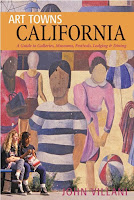Browsing in the library today I stumbled across an interesting book: Art Towns California: Communities Celebrating Creativity: Festivals, Galleries, Museums, Dining & Lodging, by John Villani . Beyond interest in the book itself, it struck me that it might be part of a series. And, indeed it is. Although it is a very short series. No matter, it's still a good one. The 100 Best Art Towns in America: A Guide to Galleries, Museums, Festivals, Lodging & Dining, by John Villani This is Villani's best known book. The DEL-100 Best Small Art Towns in America: Discover Creative Communities, Fresh Air, and Affordable Living, by John Villani Another version of this book, with the words The DEL in front of it, but I haven't quite yet discerned the difference. The main ones seem to be a focus on living in creative communities (versus just visiting art collections) and the inclusion of some Canadian cities (yeah!). I have no idea what 'The DEL' refers
